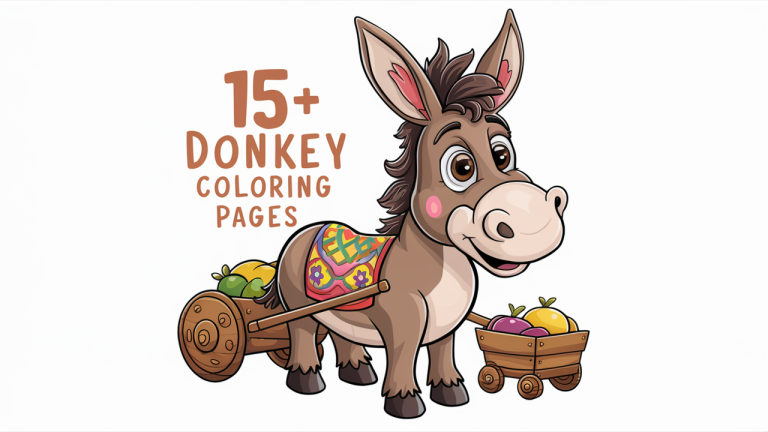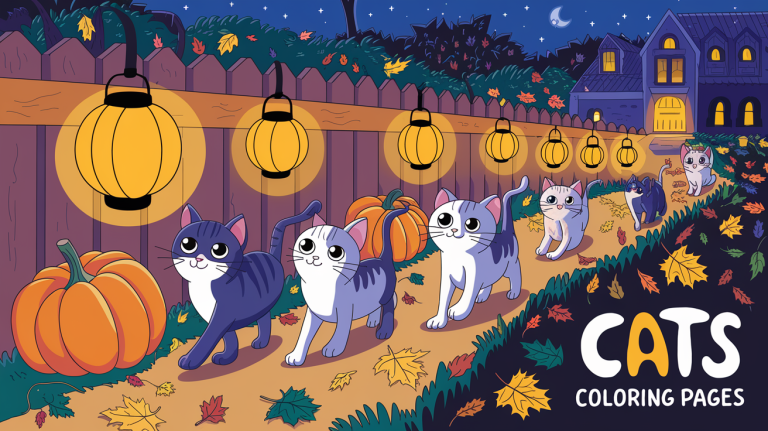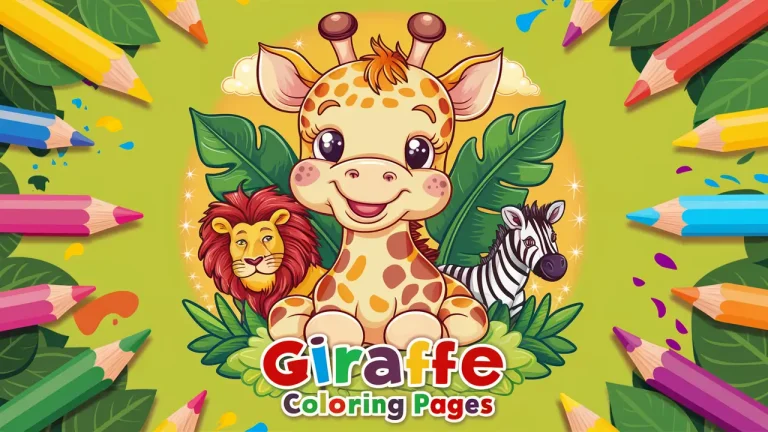Tiger Coloring Pages: Free Printables, Creative Ideas & Tips
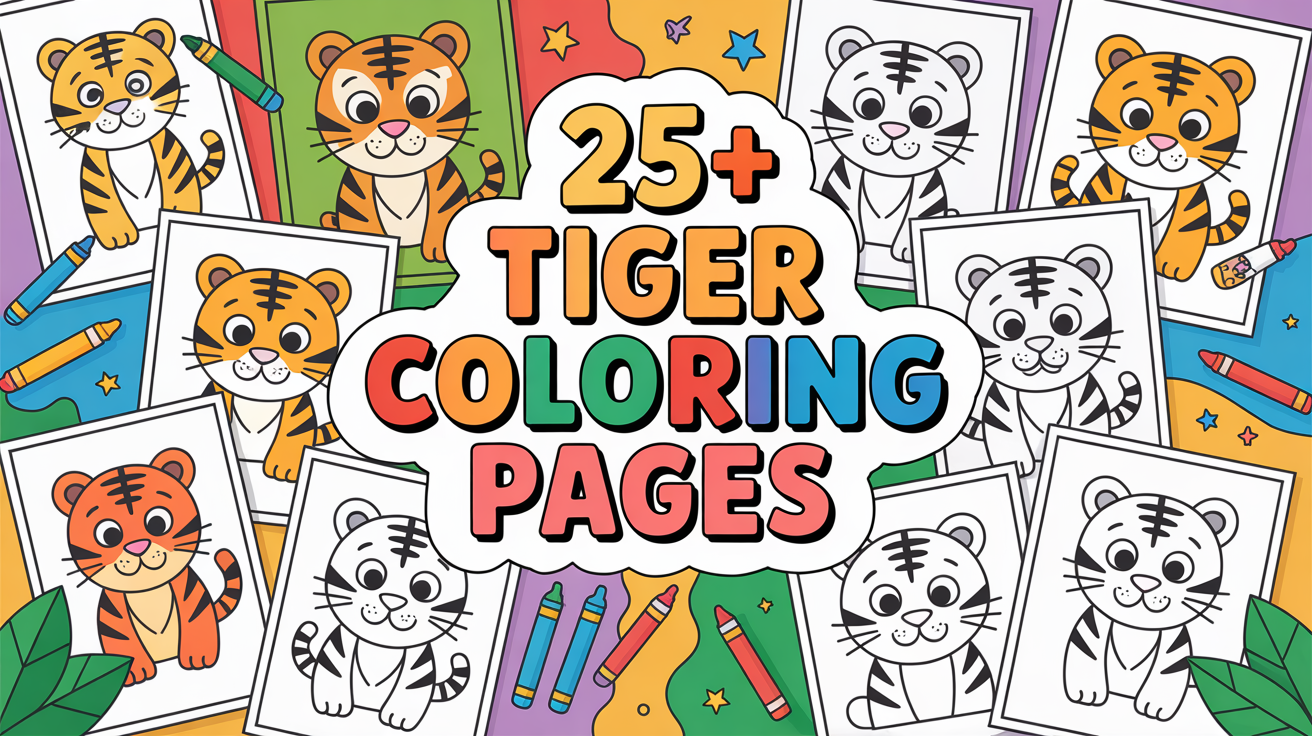
Tiger coloring pages offer a fun and creative way for people of all ages to engage with the beauty and strength of these majestic animals. Whether simple or detailed, these pages provide various styles from realistic tigers to playful cartoons and mandala designs. They are easy to download and print, making them accessible for anyone who wants to explore the world of tigers through art.
Coloring tiger pages is more than just a pastime; it can help develop fine motor skills, patience, and concentration, especially for children. These pages also serve as educational tools, encouraging curiosity about wildlife while offering a screen-free activity. Plus, they can be used in creative projects like masks, bookmarks, or decorative crafts.
With a wide range of tiger images—from cubs to adults and from abstract art to famous tiger characters—there is something suitable for every skill level and interest. This variety makes tiger coloring sheets enjoyable whether used for learning, relaxation, or family activities.

Key Takeways
- Tiger coloring pages come in many styles to suit different ages and skill levels.
- They offer both educational value and help develop important skills.
- Coloring pages can be used for creative projects beyond just coloring.
Types of Tiger Coloring Pages
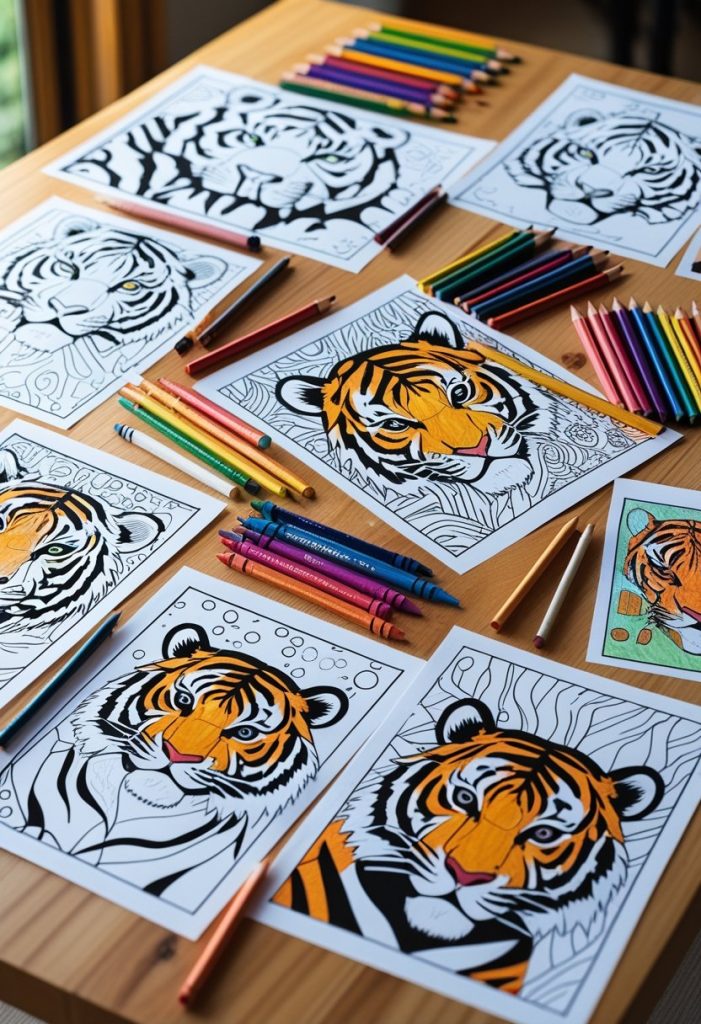
Tiger coloring pages come in several different styles that appeal to various ages and skill levels. These include detailed images that look like real animals, fun and simple cartoons, complex patterns made for focused coloring, and full scenes showing tigers in their natural settings.
Realistic Tiger Designs
Realistic tiger designs focus on accurately showing the big cat’s features. These pages include detailed stripes, muscles, and sometimes the texture of fur. They often show tigers in natural poses like stalking or resting.
Such designs are good for older kids and adults who want a challenging project. Coloring these pages helps improve attention to detail and skills like shading.
Realistic pages often teach about tiger anatomy and behaviors. They are useful for educational settings focused on wildlife or animal biology.
Cartoon and Cute Tiger Pages
Cartoon and cute tiger pages show tigers in simple or exaggerated styles. They often feature smiling faces, big eyes, and playful poses. This type appeals mostly to younger children or anyone who prefers lighthearted images.
These pages usually have bold, thick lines that make coloring easier. Many cartoon pages include tiger characters from popular stories or shows, making them familiar and fun.
Their simple design helps develop fine motor skills and creativity without being overwhelming. They are popular in classrooms and at home for early learning.
Mandala and Intricate Tiger Patterns
Mandala and intricate tiger patterns combine the image of a tiger with detailed designs inside or around it. These pages may show tiger faces filled with symmetrical shapes or bodies decorated with floral and geometric patterns.
This style suits adults or older kids who enjoy focused, meditative coloring. The detailed patterns require patience and precision, making them more challenging than simple drawings.
Mandala tiger pages also highlight the tiger’s form in a decorative way, blending art and nature. They are often used for stress relief and mindfulness.
Tiger Scenes and Landscapes
Tiger scenes and landscapes place the animal in its environment. These pages show tigers in jungles, near rivers, or resting under trees. Sometimes other animals or natural elements like flowers and mountains appear.
These coloring pages provide a storytelling aspect by showing habitat and context. They are engaging because they combine animals with the outdoors, helping users learn about tiger ecosystems.
Scenes range from simple backgrounds to detailed environments with many elements. They work well for users who enjoy drawing and coloring complex pictures that tell a story.
How to Download and Print Tiger Coloring Pages

Downloading and printing tiger coloring pages requires a few simple steps to get clear, high-quality results. It is important to find reliable, free printable coloring pages, use high-resolution PDF files, and adjust printer settings for the best print quality.
Finding Free Printable Coloring Pages
To start, look for websites offering free printables with tiger coloring pages. Many sites provide collections ranging from simple outlines to detailed drawings. Choose pages marked as free to avoid fees or copyright issues.
Use keywords like “free printable tiger coloring pages” when searching online. This helps find pages suitable for all ages. Some sites sort pages by difficulty or style, helping users pick the right design.
Check if downloadable files come in PDF format, as PDFs keep image quality intact. Also, some sites allow online coloring before downloading. Confirm that the pages are free and safe to download by reviewing site terms.
Downloading High-Resolution PDFs
Once a site is chosen, open the downloadable PDF link. High-resolution files print with sharp details. If multiple options exist, pick the one with the highest resolution or size, often labeled as “HD” or “high quality.”
Save the file to a familiar folder on a computer or device, so it is easy to find later for printing. If using a mobile device, some apps can handle downloads and printing directly.
Avoid printing from web previews or low-quality images. Always download the full PDF to get the best print results. Check file size too; larger files usually mean better image clarity.
Best Printing Tips for Quality Results
Set the printer to print on US Letter (8.5″ x 11″) or A4 paper, the most common sizes for coloring pages.
Use printer settings such as:
- Fit to Paper or Scale to Fit to ensure the whole image prints correctly,
- Best or Highest Quality mode for sharper lines and richer colors.
Choose plain white paper for the clearest colors. Thick paper or cardstock is good for markers or paints.
Preview the print to confirm page alignment and color output. Avoid using draft mode, which lowers print quality and may blur details.
Following these steps helps produce high-quality tiger coloring pages ready for coloring fun.
Benefits of Coloring Tiger Pages

Coloring tiger pages offers more than just a fun pastime. It combines learning, skill development, and emotional benefits in a simple activity. Engaging with these pages helps deepen understanding of tigers while improving important abilities and providing calmness.
Educational Value and Tiger Conservation Awareness
Tiger coloring pages introduce children and adults to important facts about tigers and their habitats. They highlight tiger features, behavior, and the challenges these animals face in the wild. This can increase awareness of tiger conservation efforts and the need to protect endangered species.
Learning through coloring helps reinforce knowledge about wildlife. It makes abstract ideas about nature and animal survival more concrete. Parents and teachers often use tiger coloring pages to spark curiosity about biology and encourage respect for the environment.
Developing Fine Motor and Artistic Skills
Coloring detailed tiger images requires precision and careful hand control. This helps develop fine motor skills, especially in young children learning to hold crayons or pencils. The repetitive actions involved improve hand-eye coordination and spatial awareness.
Artistic skills grow through experimenting with colors and patterns. Colorists practice blending shades and staying within lines. This process strengthens patience and attention to detail. The variety of tiger designs, from realistic to cartoon styles, allows for creative freedom while honing basic art techniques.
Therapeutic and Stress Relief Benefits
Coloring intricate tiger patterns can provide a relaxing break from daily stress. The act encourages focus and mindfulness, drawing attention away from worries. This quiet, meditative time fosters calmness and mental clarity.
Adults and children alike benefit from the soothing rhythm of coloring. It can reduce feelings of anxiety and promote emotional balance. Using tiger pages also reconnects individuals with nature, reminding them of the beauty and importance of wildlife preservation.
Creative Uses for Tiger Coloring Pages

Tiger coloring pages can be used beyond just coloring. They provide options for making creative objects, decorating spaces, and enhancing personal projects with animal-themed art.
Arts and Crafts Projects
Tiger coloring pages can be turned into various craft items. For example, printing them on thicker paper lets users create masks. They color the tiger face and cut out eye holes, then attach a string to wear the mask.
Another idea is making stick puppets by coloring a tiger image, cutting it out, and gluing it to a popsicle stick. This is great for storytelling or imaginative play.
Additionally, coloring pages can become puzzles. After coloring, glue the page to cardboard, cut it into pieces, and mix them for a simple homemade puzzle. These crafts keep kids engaged and turn free printables into lasting keepsakes.
Party and Classroom Decorations
Tiger coloring pages serve as colorful party and classroom decor. They can be printed multiple times, colored, cut out, and strung together to form a banner. This adds a jungle or animal-themed flair to birthday parties or school events.
Teachers can also use these animal coloring pages for bulletin boards. Having students color various tiger designs and display them creates a vibrant “Roar Into Learning” theme.
For party tables, cut-out tigers can act as centerpieces or be glued onto party hats and goodie bags. This approach personalizes the space using simple, free printable resources.
Scrapbook and Journal Ideas
Tiger coloring pages make interesting additions to scrapbooks and journals. Colored images of tigers or tiger cubs can be glued onto pages as decorative accents.
Users can combine these images with handwritten notes, stickers, or photos in nature-themed journals. This brings an artistic touch to personal memory books or creative writing projects.
Another option is using small colored sections from tiger pages as bookmarks or inserts. Laminating these makes them durable and visually appealing while promoting animal appreciation in everyday use.
Exploring Tigers Through Coloring

Tigers are more than just beautiful animals. They live in diverse places and have special traits that make them unique among big cats. Learning about their homes, habits, and conservation helps deepen the connection through coloring.
Learning About Tiger Species and Habitats
There are six main tiger subspecies alive today: Bengal, Siberian, Indochinese, Malayan, South China, and Sumatran. Each subspecies lives in distinct regions, from the cold forests of Siberia to the tropical jungles of Sumatra.
Tigers prefer dense forests, grasslands, and mangrove swamps. Their choice of habitat affects their size, color, and hunting style. For example, Siberian tigers are the largest and have thicker fur for cold climates, while Sumatran tigers are smaller with darker stripes suited for dense rainforests.
Understanding these differences helps people appreciate the diversity tigers bring to various ecosystems and why protecting their habitats is essential.
Important Facts About Big Cats
Tigers are the largest members of the big cat family, which also includes lions, leopards, and jaguars. They can weigh up to 670 pounds and measure over 10 feet from nose to tail.
Big cats are carnivores with sharp teeth and strong muscles for hunting. Tigers have excellent night vision and use their striped coats as camouflage.
They are solitary animals and mark territories using scent marks and roars. Tigers play a vital role in keeping ecosystems balanced by controlling prey populations.
Tiger Conservation and Endangered Status
Tigers face many threats, such as habitat loss, poaching, and conflicts with humans. Their numbers have dropped by over 95% in the past century.
Conservation efforts include protected parks, anti-poaching patrols, and breeding programs. Organizations work globally to restore tiger habitats and raise awareness.
Tiger subspecies like the South China tiger are critically endangered or possibly extinct in the wild, making conservation urgent. Supporting these efforts is necessary to prevent further decline and preserve tigers for future generations.
Related Animal Coloring Pages

There are many animal coloring pages that complement tiger designs well. Some feature other big cats, while others offer a wider variety of animals. Mixing different types of animal pages can create a more engaging experience for kids and adults alike.
Other Big Cat Coloring Pages
Big cat coloring pages include lions, leopards, jaguars, and cheetahs. These pages often share similar features like stripes or spots, making them great for practicing shading and patterns. Lions usually come with their iconic mane, while leopards and cheetahs focus on spots and sleek shapes.
These pages help users learn about different species and their habitats. They range from simple cartoon styles to realistic drawings with detailed backgrounds. Many free printable coloring pages include sets of big cats, allowing for easy access and a variety of choices.
Popular Free Printable Animal Pages
Beyond big cats, popular free printable animal pages include pets like dogs, cats, and rabbits. These are often simpler and great for younger children learning basic coloring skills. Wildlife animals, such as elephants, bears, and birds, are also common choices.
These printable pages are usually available in PDF format and easy to download. They cater to different skill levels with a mix of simple designs and complex scenes. Kids and adults can enjoy coloring animals from farms, jungles, oceans, and forests alike.
Tips for Mixing and Matching Animal Collections
Combining tiger coloring pages with other animals can make a fun, educational collection. One tip is to select animals from similar environments, like jungle animals, to create a themed set. Another way is to mix big cats with smaller pets, introducing variety and contrast.
Using pages with different levels of detail helps maintain interest. Parents and teachers can encourage exploration by pairing realistic pages with cartoon versions. Creating banners or storybooks from mixed collections adds a creative twist to coloring activities.
Frequently Asked Questions
Many tiger coloring pages come in different styles and levels of detail to suit various ages and preferences. They are available in formats that allow easy printing and downloading.
What are some simple tiger coloring sheets for young children?
Simple sheets usually have large shapes and fewer details. These pages help young children practice coloring without feeling overwhelmed.
They often feature bold outlines and basic tiger shapes that are easy to fill in.
Where can I find printable tiger coloring pages suitable for adults?
Adults may prefer more detailed and lifelike tiger designs. These coloring pages include complex patterns and realistic portraits.
Websites that offer free printables often provide options labeled as “intricate” or “realistic” for advanced colorers.
How can I access high-quality realistic tiger coloring pages?
High-quality pages are usually available as PDF files. These files keep the details sharp when printed in larger sizes.
Look for collections that highlight lifelike tiger features and natural settings, such as forests or mountains.
What options are available for cute tiger-themed coloring pages?
Cute tiger pages often show tigers in playful or cartoon styles. They might have softer lines and friendly expressions.
These designs suit younger kids or anyone looking for a fun, less serious way to color tigers.
Can I download tiger coloring pages in PDF format?
Yes, many sites offer free PDFs for easy download and printing. PDFs maintain image quality and fit standard paper sizes like US Letter and A4.
Downloading PDFs lets users print as many copies as needed without loss of detail.
Are there any baby tiger coloring sheets that I can print for my kids?
Yes, baby tiger coloring pages focus on young tigers with simpler, softer designs. These are great for children who enjoy coloring animals that appear gentle and cute.
They usually include fewer details and emphasize round shapes to make coloring easier.
Photo Gallery

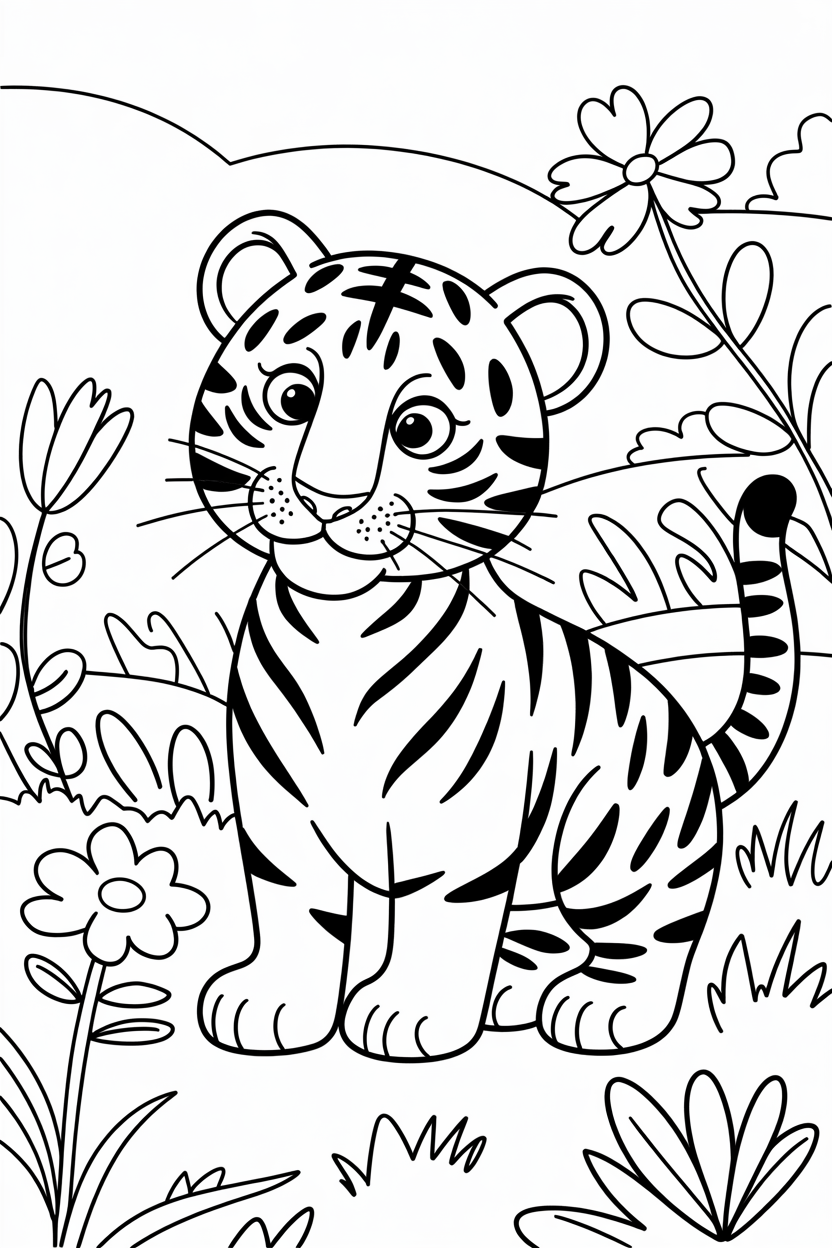
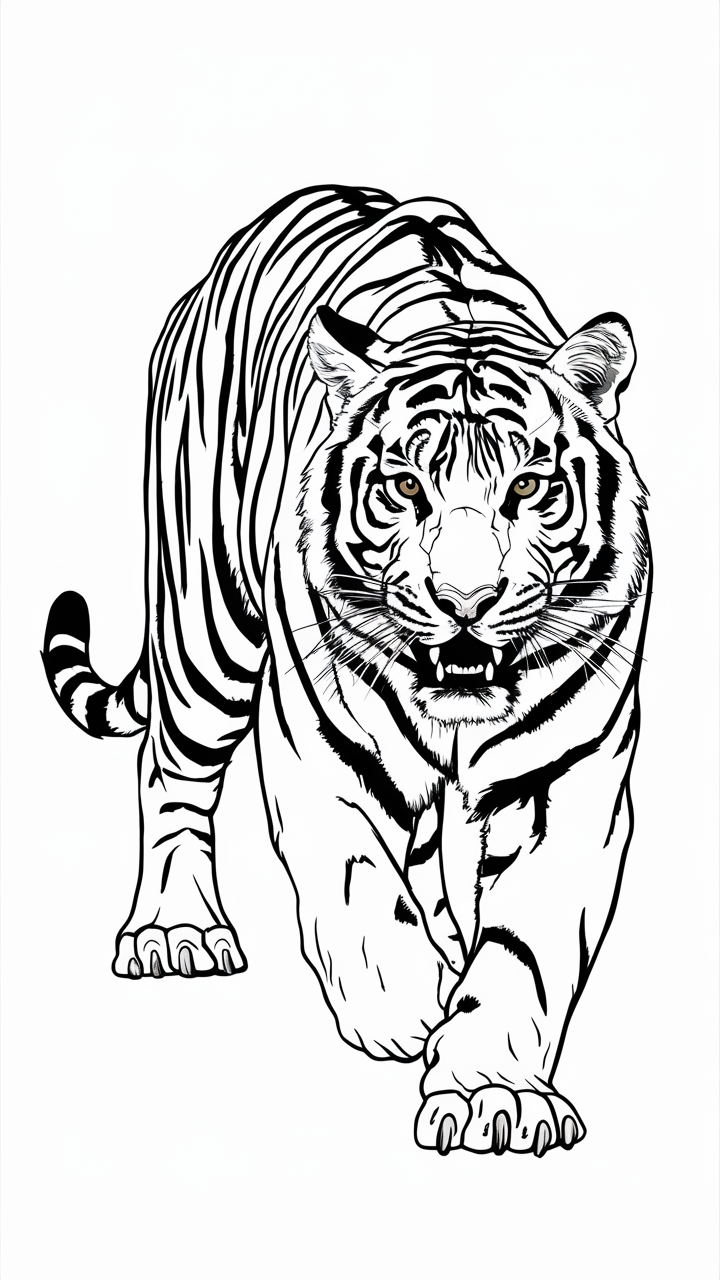
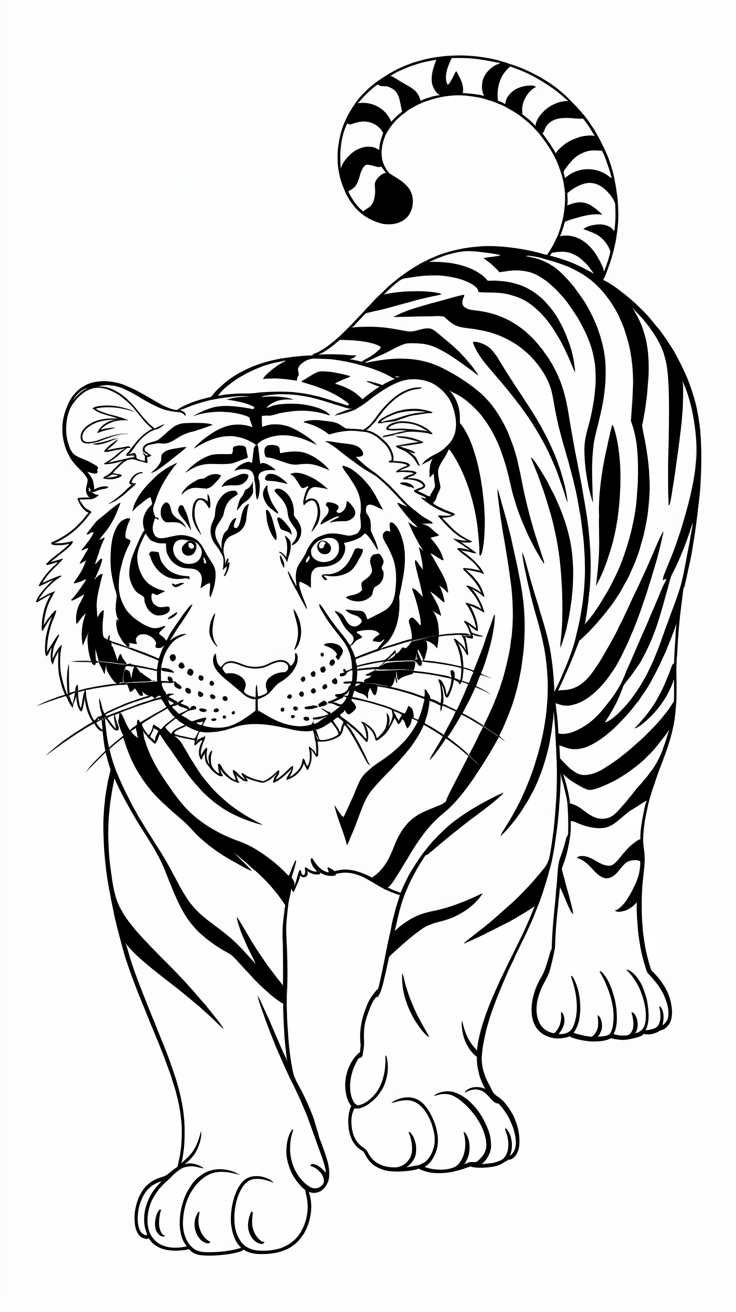


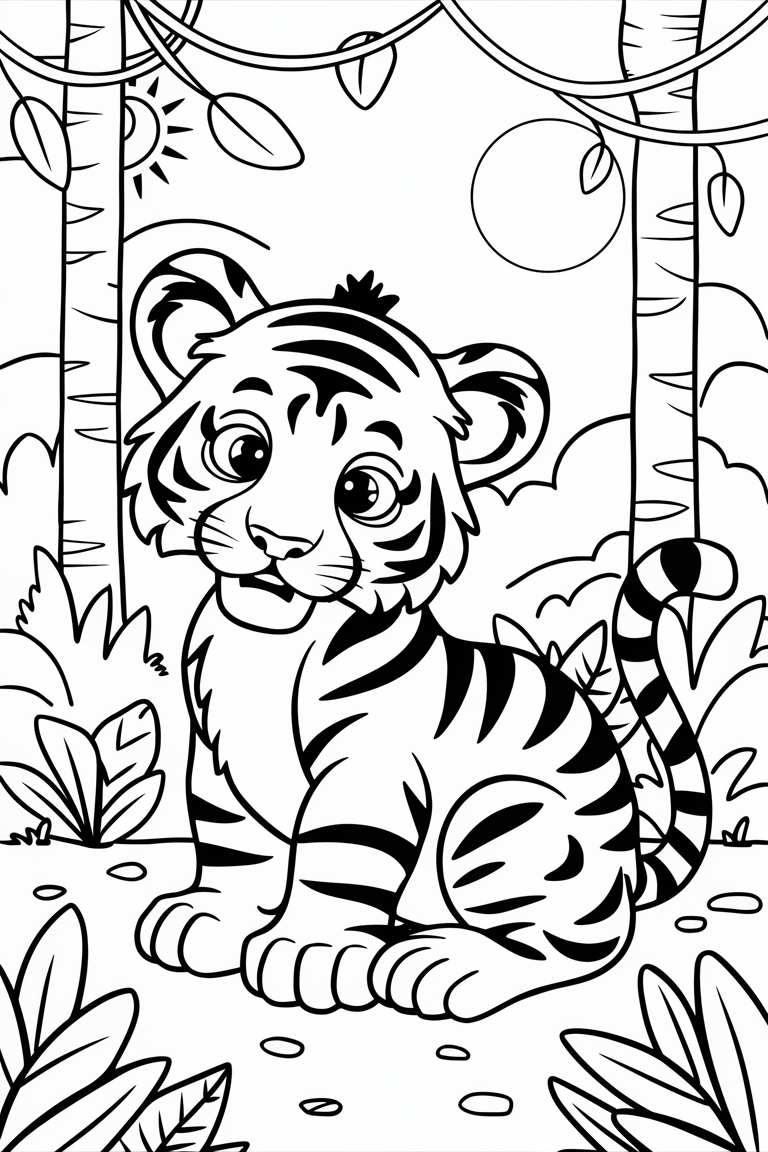
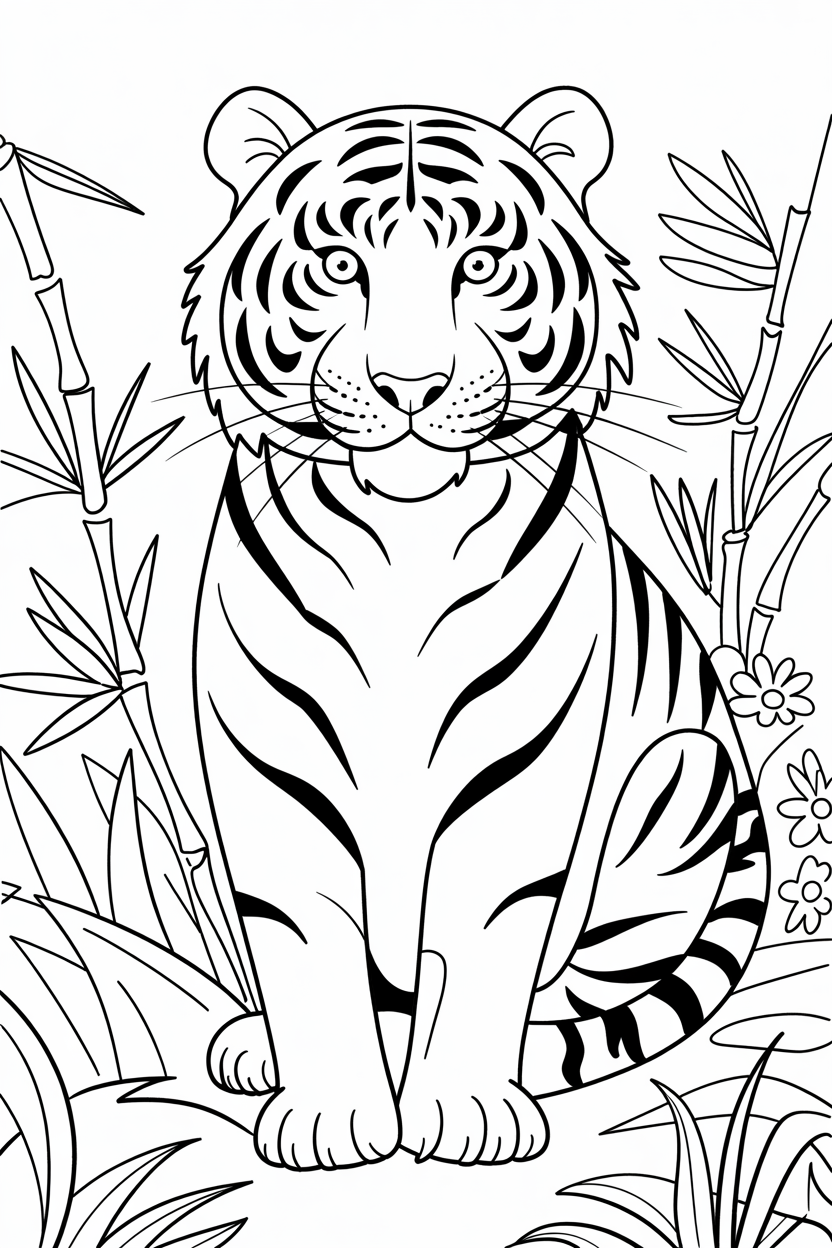
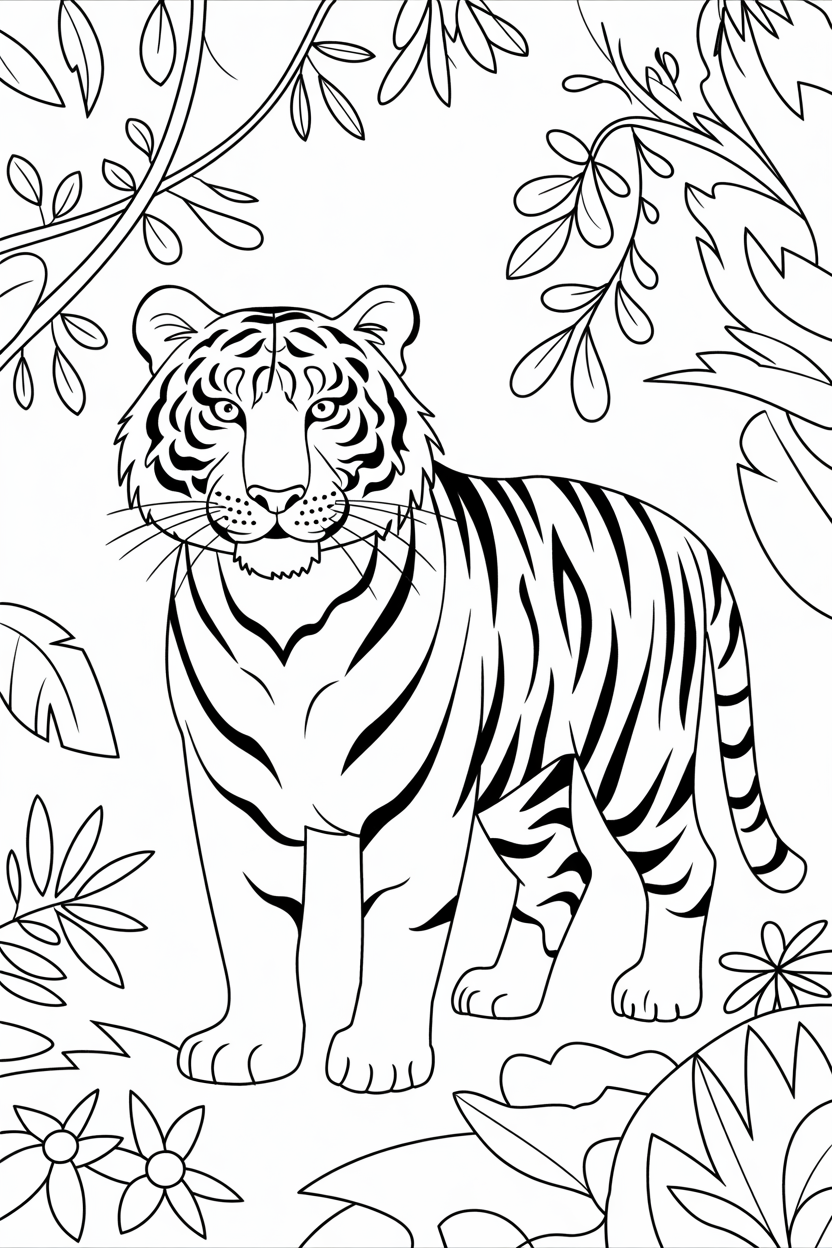

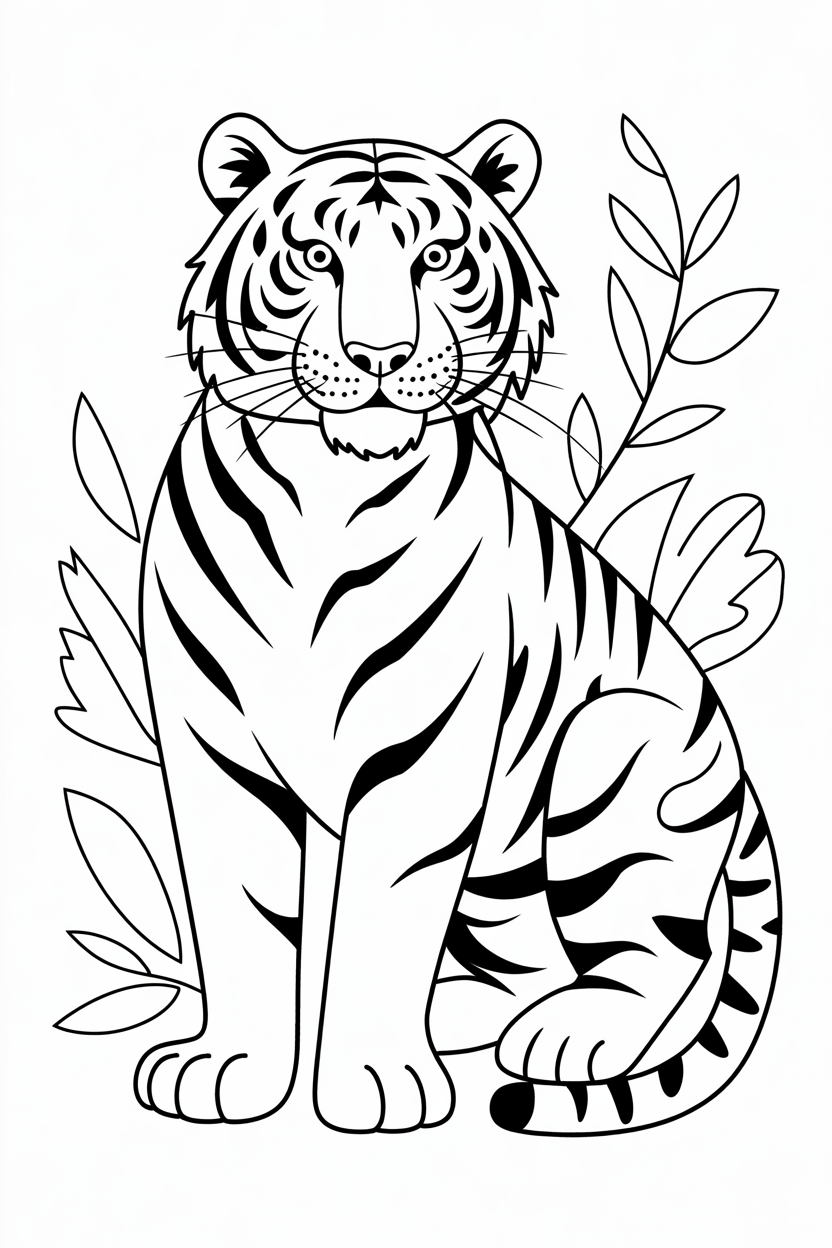
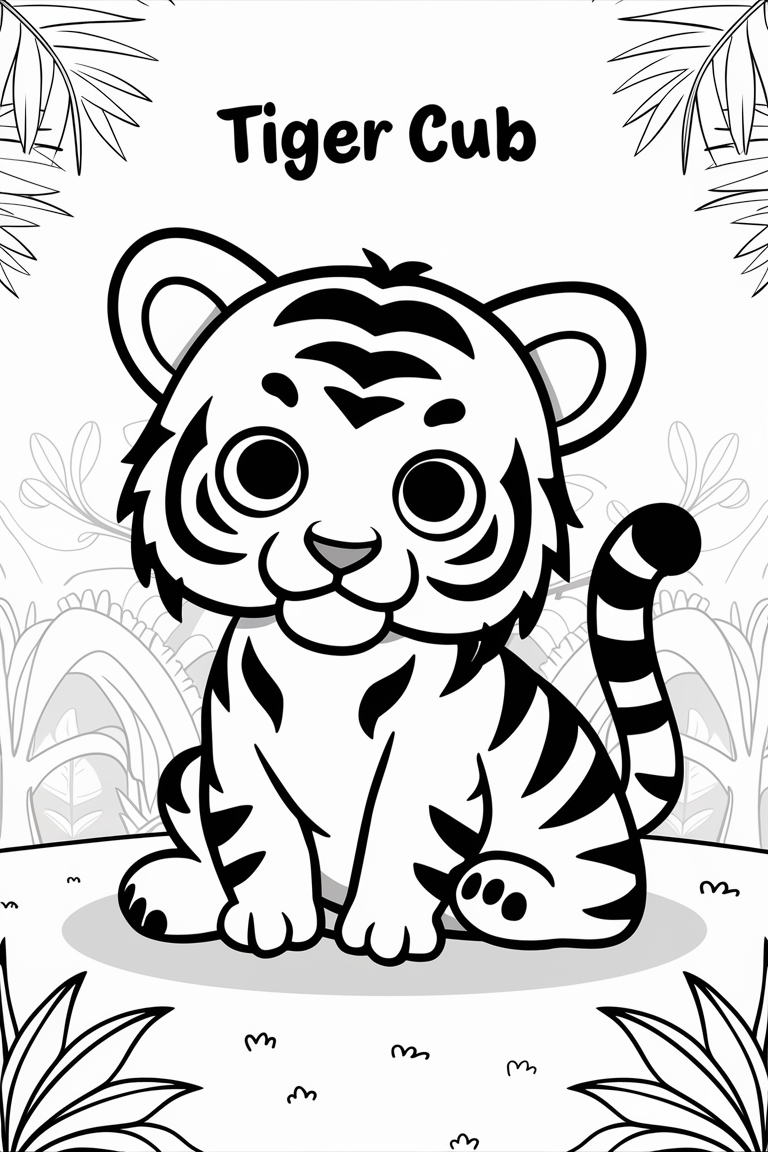
Final Thoughts
Tiger coloring pages offer more than just a fun activity. They provide a way for children and adults to connect with nature while practicing creativity. Each page invites the colorist to explore the tiger’s environment and unique features.
These pages can be used for learning. By coloring, people can develop fine motor skills and understand more about wildlife and habitats. They can also be a tool to discuss important topics like conservation.
The variety of designs—from simple outlines to detailed, realistic images—makes these pages suitable for all ages and skill levels. This flexibility allows them to fit different educational or recreational needs.
Ways to use tiger coloring pages:
- Classroom projects or homeschooling lessons
- Rainy day indoor activities
- Travel entertainment
Coloring these images encourages focus and imagination. It helps both kids and adults relax while engaging with a subject that is both beautiful and important. With tiger coloring pages, every session can be a small step toward awareness and creativity.

